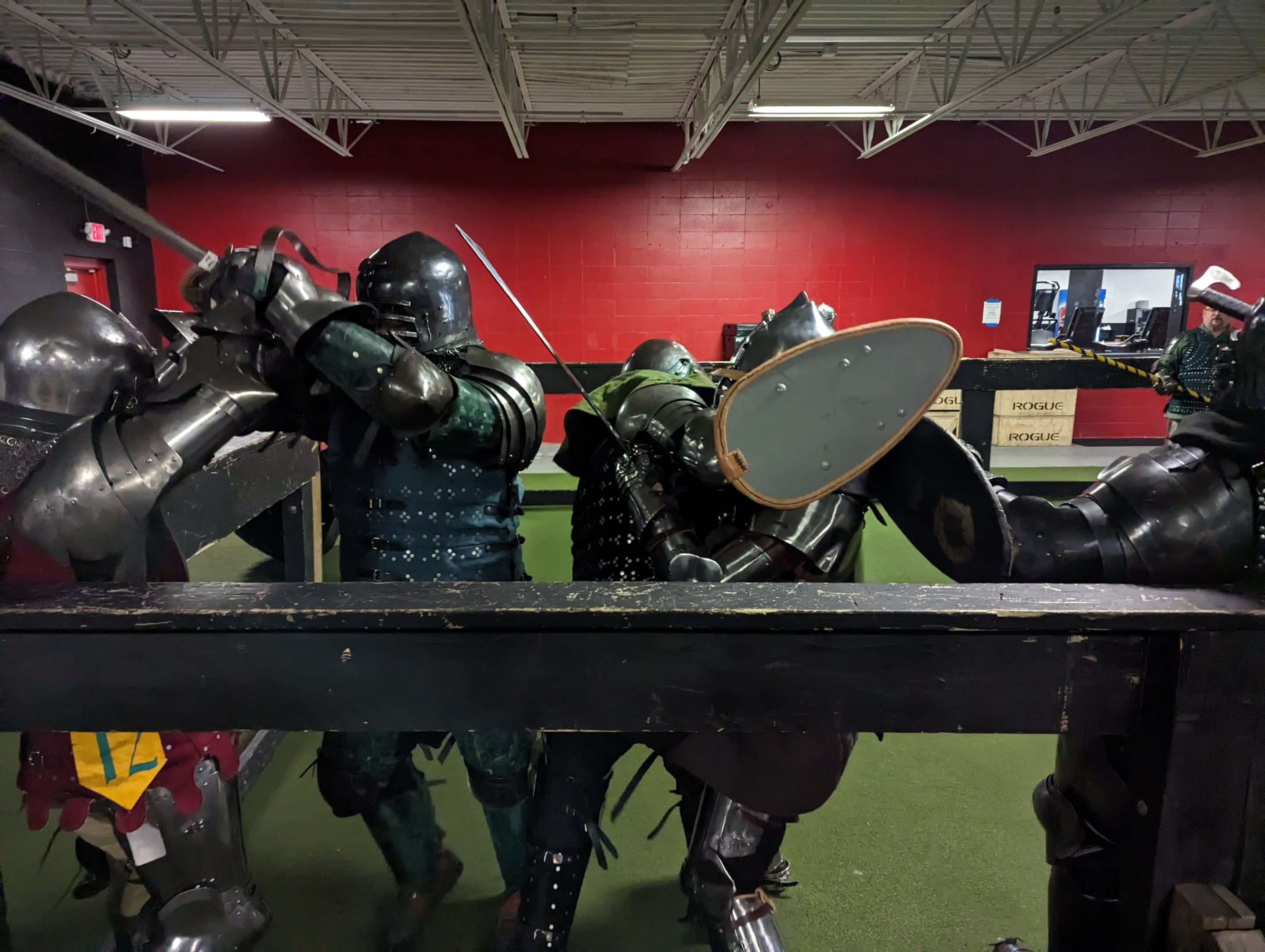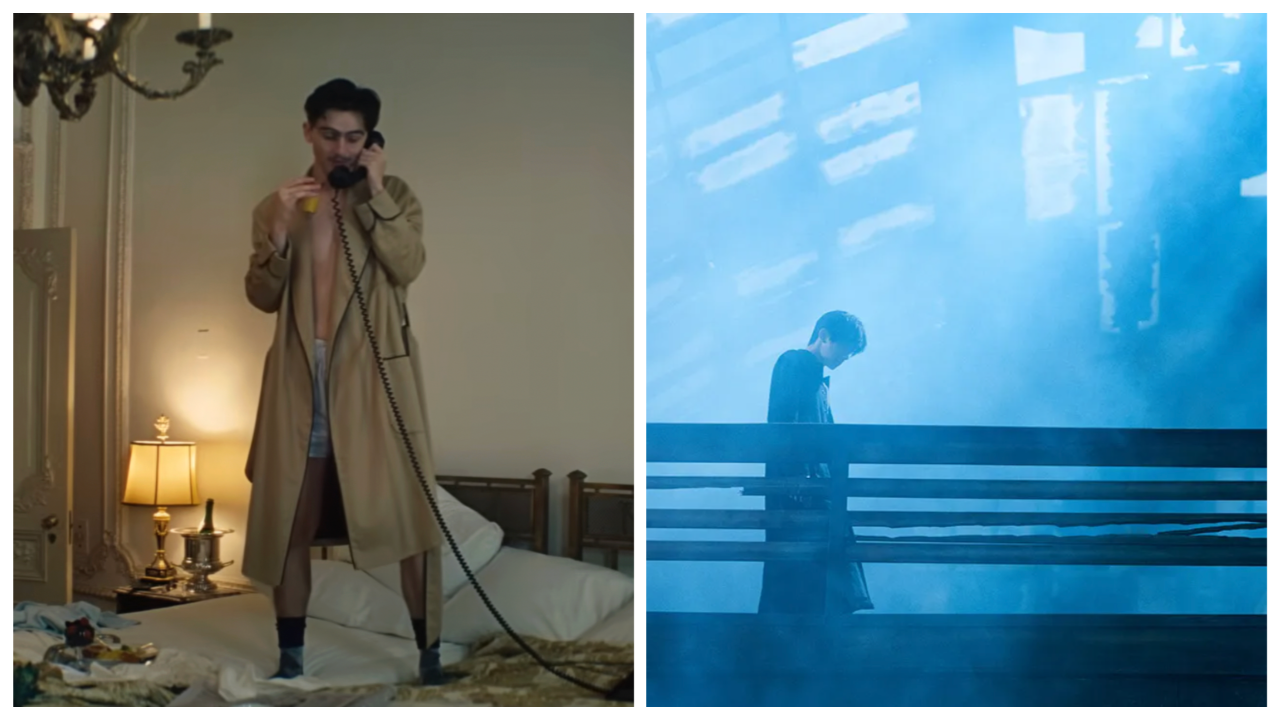Keegan Kropf is strapping a pair of forest green plate greaves to his shins, as a group of 10 people gets armored up around him. Arms, legs, and torsos dressed in sweats and modern athletic tights disappear, piece by piece, into thick gambesons, shining cuirasses, and jointed gauntlets. It takes every second of a full 20 minutes, at the fastest, to put on a full suit of plate armor. “If we’re contractually obligated to put on our show at 1 p.m.,” Kropf says, “we start yelling at people to start getting ready at noon.”
Kropf is a member of the Twin Cities Wyverns, who are currently getting ready for their version of a full-pads practice. Welcome to the sport of Armored Combat, also known as Historical Medieval Battles, also known as buhurt (a term which comes from Old French words for “jousting” and “lance”).
We’re standing in the new Los Campeones gym in St. Paul, so unfortunately there are no horses, and no lances either. This sport isn’t scripted or staged, and the combat itself is real. If you’re thinking of the show fights you’ve seen at Ren Fest or Medieval Times, those are pro wrestling in armor. This is like the MMA version of that.
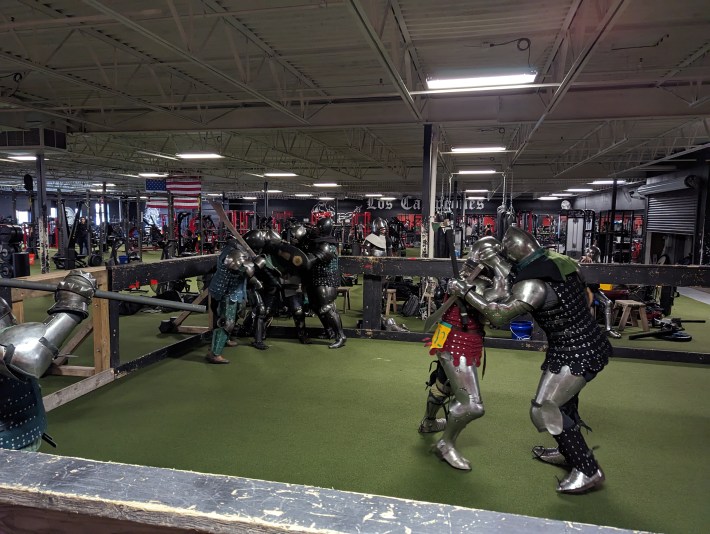
Started in 2015, the Wyverns (“why-verns”) are Minnesota’s Armored Combat squad, and they’ve gathered in the gym to get in a practice before game day on Saturday, May 13. There are two different Armored Combat leagues that operate in the U.S.—the International Medieval Combat Federation and Buhurt League—but teams don’t really “belong” to one league or the other and can compete in events hosted by either.
Matches happen when teams organize them between themselves, and some teams host small annual tournaments. Then, each league hosts a larger tournament that determines the national champion who will represent the U.S. in international competition that year. (The May 13 bout was supposed to be against the Cincinnati Barbarians, but the Ohioans had to cancel, which is why the Wyverns are going to host a small round-robin tournament of ad-hoc teams instead.)
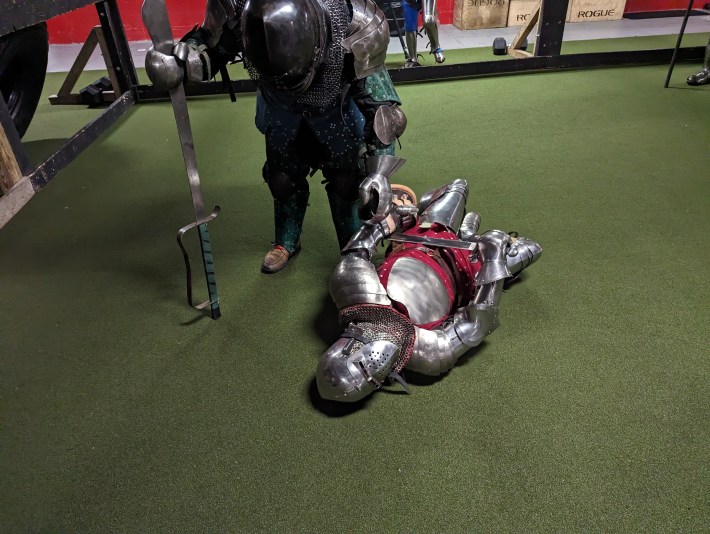
Armored Combat is a martial arts game, so like boxing, Muay Thai, or MMA, there are rules to keep it safe(ish) and give it the contours of what its practitioners want to see. Just as boxing wants to be about punching rather than kicking or wrestling, Armored Combat wants to be about the weapons and armor. So you can’t, for example, just drop your weapon and spear tackle a guy.
The gear is very much the sport’s defining engine. The rulebook lays out specifications for approved size, shape, and weight ranges for the equipment. Within those ranges, it’s up to you. “It’s kind of like hockey,” says Wyvern Josh Berg, “where you have different stick sizes, different dimensions.”
Those familiar with fantasy video games will understand the fun in choosing your own identity: Are you a halberd guy, for reach? Are you a dual-wield guy, for brawling? Are you a sword-and-board guy, for defensiveness and counters?
The extensive gear requirements also make for a pretty hefty price tag for entry and maintenance. “It’s not a cheap sport to be in,” admits team captain Spence Fasching. “I usually joke with people: This sport isn’t for poor people, just a lot of poor people do it.”
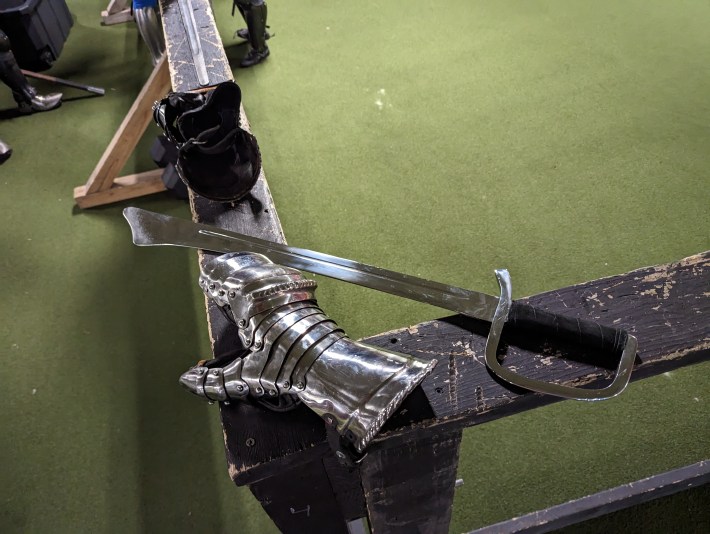
The Wyverns would be hamstrung without Fasching. He’s very much the organizer, facilitator, and head coach. “I used to try to do everything, then I discovered delegation,” he says. He manages the pool of loaner equipment that can be shared, which enables players who haven’t yet assembled their own kits to participate, which is essential because this particular practice brought in a few newbies who had never had any live, in-armor action before. Fasching estimates having spent a total of over $15,000 (!) of his own money on armor for himself and for the team over the years.
Arranging practice time and space at the St. Paul Los Campeones was another game-changing stroke of fortune for the Wyverns, Berg says. “Ben [Loehrer, the owner] and Dave [Sikorski, a manager] at Los Campeones have been super great to us. Giving this space to practice in, indoors, in Minnesota—you need it. We were really foundering for a place to be able to do this stuff all year round, and they’ve made a spot for us.”
The gym took over an industrial park building in the West Side, which means the floor is enormous, and much of it is covered in the indoor field turf for things like sled pushing and ladder drills. With the gym’s surplus space, the Wyverns can quickly assemble a wooden paddock for themselves, about 25 by 25 feet, on a portion of the turf next to the heavy bags, without imposing on anyone else’s workout.
Except for the noise, that is. Metal on metal impact still makes a racket.
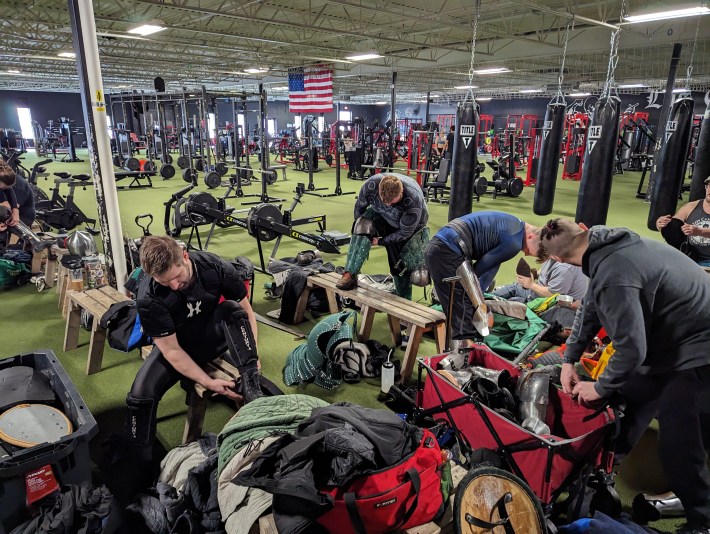
The Wyverns do a quick warm up like a football team—some high-knees and knee-bends in lines up and down the turf, pushing a weighted sled a bit—and then when everyone is set, they start practice in earnest.
Here’s how it works. There are two general discipline categories. The first is 1v1 matches, which are about point-scoring. A duel looks how you might think fencing with heavier weapons would look. Whack a legal scoring area, and judges add up points. Another rule set for the 1v1s is nicknamed “pro fight.” Unlike in standard duels, punches, kicks (leg kicks are a useful move here), and grappling are allowed. There’s also bonus scoring applied to delivering blows to a downed opponent, like an MMA ground-and-pound with weapons.
The other broad category of Armored Combat is team melees, the Wyverns’ preferred format. These can be any team size, but American teams tend to like 5v5. The idea is to knock all the opposing players off their feet, and a match is best of three rounds. It’s a different game objective than striking for points, so weapons are as much for tangling up an opponent as they are for just wailing on them. Pure striking takes a backseat to grappling, since you always have to have at least one hand on a weapon, and the gauntlets limit finger articulation anyway. The action is guardrailed by rules from turning into straight-up wrestling. A player is knocked out of the round if any part of them other than their feet contacts the ground for more than a split second. And, hilariously, they then have to lie there on the ground and become a passive obstacle, simulating a battle casualty.
Melee rounds feature plenty of cautious posturing, with the occasional grappling stalemate, but also blink-and-you’ll-miss-it bursts of excitement when someone charges or hits the ground. The action has a bit of a sumo feel. At a macro level, these team fights end up being about exploiting moments for a double-team, and so there’s a touch of Xs & Os reminiscent of football offensive-line movements to create a crucial mismatch.

Kropf has a linebacker’s instincts for shuffling laterally, looking for the space he wants, and then exploding into it with decisive commitment to deliver a charging shove. Stocky and one of the more athletic Wyverns, a blitzing Kropf stands a good chance of bowling an opponent right over. “But it’s practice,” Fasching says. “So we’re not swinging for the fences in practice.”
Double-team takedowns are the team's first drill, with one player grappling another and then passing him to a teammate to attempt a foot-sweep move. They eventually move on to 3v3 scrimmages, setting up different game situations—for example, one team hugging the edge of the square while the other tries to attack this turtling phalanx.
In competition, the Wyverns are pretty legit.
“We’re one of the best teams in the Midwest,” Berg boasts. “Everyone says that. There’s Knyaz [a team from Michigan], and then there’s us. They’re one of the top teams in the U.S. Locally in the Midwest, we do really well, but then when we go to national competitions, it can be a slug fest. We take a lot of damage.”
The Wyverns have had godawful luck in national tournaments, getting matched in the first round of the last three tournaments against Dominus, a dominant team that has managed to assemble a roster of guys from the Pacific Northwest, Texas, California, and Australia. Dominus just took home gold in the Buhurt League World Cup 2023, so right now they’re the No. 1 Armored Combat team on the planet. Minnesota sports fans can relate to this clockwork post-season misery.
“It made me feel better seeing the top tier European teams get just clocked by them too,” Berg says.
Check out the Wyverns in action this Saturday, May 13 at Los Campeones in St. Paul’s West Side (155 Eaton St.). On August 12, they’re hosting a tournament titled “War in the North” at the Adrenaline Sports Center in Ramsey.
